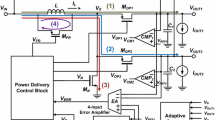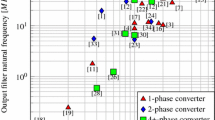Abstract
This study is dedicated to design and realization of a new single inductor bipolar multi-output (SIBMO) DC–DC converter with performance improvement. A bandgap is first designed to offer a stable input bias with capability to work against inevitable input voltage variations for avoiding possible p-n breakdowns. A new drive technique based on constant on-time (COT) is developed for the designed SIBMO with assistance from level shifters and zero current detection circuits to drive MOS devices. The designed circuit is capable of boosting input voltage 2.8 V to four bipolar outputs of +6, −6, +12 and −12 V. The COT proposed herein adopts a new technique of time multiplexing to offer stable multi-outputs with an off-chip inductor for fast switchings. This new COT is different from the conventional pulse width modulation which usually operates with fixed frequencies. The COT is particularly favorable in regards of crossing regulation and high transfer efficiency in cases of unbalanced loads. The proposed SIBMO and COT are applicable to drive systems of organic light-emitting diodes, optical sensors, and portable electronic devices, displays, etc. The designed on-chip SIBMO and COT are fabricated via the TSMC 0.25 µm high-voltage CMOS process. Experimental results clearly show the capability of the designed SIBMO chip to offer four bipolar, stabilized output voltages with a total power consumption minimized to 320 mW and the switching frequency varying from 650 to 500 kHz. Most importantly, the maximum efficiency reaches 83.1 %.

















Similar content being viewed by others
References
Benadero L, Moreno-Font V, Giral R, El Aroudi A (2011) Topologies and control of a class of single inductor multiple-output converters operating in continuous conduction mode. Power Electron IET 4:927–935
Bianco A, Adragna C, Scappatura G (2014) Enhanced constant-on-time Control for DCM/CCM boundary boost PFC pre-regulators: implementation and performance evaluation. applied power electronics conference and exposition (APEC), 2014 Twenty-Ninth Annual IEEE
Chae CS, Le HP, Lee KC, Cho GH, Cho GH (2009) A single-inductor step-up DC–DC switching converter with bipolar outputs for active matrix OLED mobile display panels. IEEE J Solid State Circuits 44(2):509–524
Chang CK, Su CH, Kao YH, Yu MH, Sauter T, Chao P (2013) A new single inductor bipolar multiple output (SIBMO) boost converter using pulse frequency modulation (PFM) control for OLED drivers and optical transducers. IEEE Sensors Conference
Chen CJ, Chen D, Tseng CW, Tseng CT, Chang YW, Wang KC (2011) A novel ripple-based constant on-time control with virtual inductor current ripple for buck converter with ceramic output capacitors, Applied Power Electronics Conference and Exposition (APEC), Twenty-Sixth Annual IEEE
Chen CM, Liao TW, Hsu KH, Hung CC (2012) A single-inductor multiple-output boost converter with freewheel charge-pump control. In: Proceedings of the ESSCIRC
Hajmohammadi MR, Moulod M, Joneydi Shariatzadeh O, Nourazar SS (2014) Essential reformulations for optimization of highly conductive inserts embedded into a rectangular chip exposed to a uniform heat flux. J Mech Eng Sci 228:2337–2346
Hayder AS, Park HG, Kim H, Lee DS, Abbasizadeh H, Lee KY (2015) A single inductor dual output synchronous high speed DC-DC boost converter using type-III compensation for low power application. IEIE Trans Smart Process Comput 4(1):44–50
Jing X, Mok PKT (2013) Power loss and switching noise reduction techniques for single-inductor multiple-output regulator. IEEE Trans Circuits Sys I 60(10):2788–2798
Jing X, Mok PKT, Lee MCA (2011) A wide-load-range constant-charge-auto-hopping control single-inductor-dual-output boost regulator with minimized cross-regulation. IEEE J Solid State Circuits 46(10):2350–2362
Ker MD, Chen JS, Chu CY (2004) A CMOS bandgap reference circuit for SUB-1-V operation without using extra low-threshold-voltage device. In: Proceedings of the 2004 international symposium on circuits and systems, vol 1. pp 41–44. doi:10.1109/ISCAS.2004.1328126
Le HP, Chae CS, Lee KC, Wang SW, Cho GH, Cho GH (2007) A single inductor switching DC–DC converter with five outputs and ordered power-distributive control. IEEE J Solid State Circuits 42(12):2076–2714
Lee YH, Yang YY, Wang SJ, Chen KH, Lin YH, Chen YK, Huang CC (2011) Interleaving energy-conservation mode (IECM) control in single-inductor dual-output (SIDO) step-down converters with 91% peak efficiency. IEEE J Solid State Circuits 46(4):904–915
Ma D, Ki WH, Tsui CY, Mok PKT (2001) A 1.8 V single-inductor dual-output switching converter for power reduction techniques. In: Symposium on VLSI circuits. Digest of technical papers. IEEE, Kyoto, Japan, pp 137–140
Ma D, Ki WH, Tsui CY, Mok PKT (2003) Single-inductor multiple-output switching converters with time-multiplexing control in discontinuous mode. IEEE J Solid State Circuits 38(1):89–100
Mok PKT (2013) Single-inductor-multiple-output DC–DC converter design. IEEE Custom Integrated Circuits Conference (CICC)
Patra P, Patra A, Misra N (2012) A single-inductor multiple-output switcher with simultaneous buck, boost, and inverted outputs. IEEE Trans Power Electron 27(4):1936–1951
Patra P, Ghosh J, Patra A (2013) Control scheme for reduced cross-regulation in single-inductor multiple-output DC–DC converters. IEEE Trans Ind Electron 60(11):5095–5104
Seol KS, Woo YJ, Cho GH, Gho GH, Lee JW (2009) A synchronous multioutput step-up/down DC–DC converter with return current control. Express Briefs IEEE Trans Circuits Sys II 56(8):210–214
Wei IC, Chen D, Lin YC, Chen CJ (2012) The stability modeling of ripple-based constant on-time control schemes used in the converters operating in DCM. International Conference on Renewable Energy Research and Applications (ICRERA)
Xu W, Li Y, Gong X, Hong Z, Killat D (2010) A dual-mode single-inductor dual-output switching converter with small ripple. IEEE Trans Power Electron 25(3):614–623
Acknowledgments
This work was supported by Sitronix, Crop., Ministry of Science and Technology, Taiwan, Project Nos. MOST 104-2923-M-009-002 and 103-2622-E-009-014-CC3; also in part by UST-UCSD International Center of Excellence in Advanced Bioengineering sponsored by the Ministry of Science and Technology I-RICE Program under Grant Number: MOST 103-2911-I-009-101.
Author information
Authors and Affiliations
Corresponding author
Rights and permissions
About this article
Cite this article
Chao, P.C.P., Chang, CK., Cheng, CK. et al. A new single inductor bipolar multi-output (SIBMO) DC–DC converter driven by constant on-time with improved performance. Microsyst Technol 22, 1405–1418 (2016). https://doi.org/10.1007/s00542-016-2868-5
Received:
Accepted:
Published:
Issue Date:
DOI: https://doi.org/10.1007/s00542-016-2868-5




